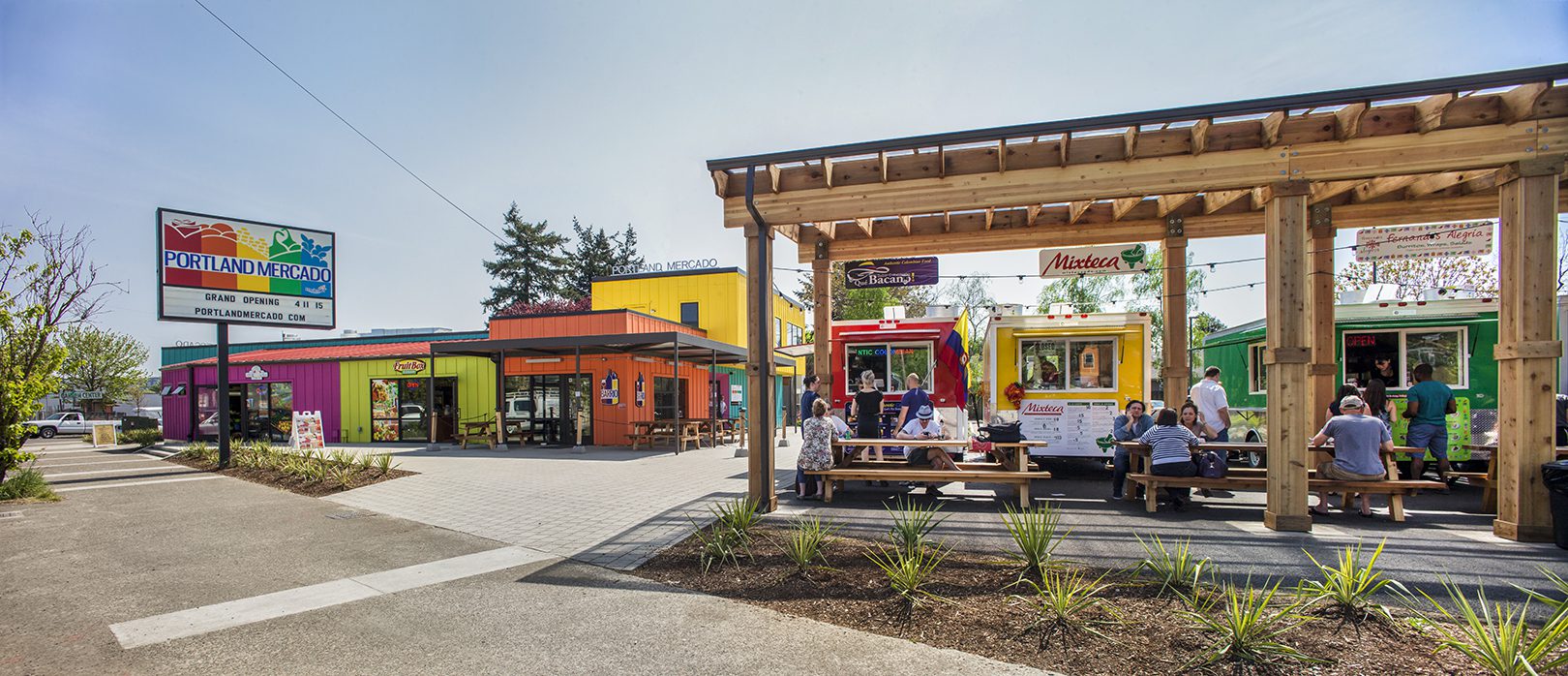
The Portland Mercado is Portland, Oregon’s first Latino public market. After its first year of operation, the market created 114 jobs, supported 19 businesses, and generated $2.5 million in gross sales. Photo courtesy of the Hacienda Community Development Corporation
Transit-oriented development (TOD) has developed a track record for city-scale and regional development, based on the assumption that clustering mixed-use development around transit centers will reduce fuel consumption and carbon emissions while promoting healthy lifestyles and socioeconomic integration. The effects of TOD have been mostly positive: TOD developments have reduced congestion and associated climate impacts, and spurred market-rate development, but they may also in some cases have accelerated gentrification and displacement of low-income communities. Further, TOD is capital-intensive and most feasible in regions with robust local tax bases and supportive policy environments.
Food-oriented development (FOD) is an alternative community development paradigm that is easier to implement in a variety of local contexts, is less capital-intensive, can be achieved at multiple scales, and offers the potential to build wealth within communities that have historically been excluded from traditional capital markets, particularly communities of color and immigrant and refugee communities.
A Public Health Partnership
The community development field has always sought to create pathways for economic security and mobility for low-income families and individuals. While affordable housing might be the most visible product, many community development practitioners view their mission more expansively to include workforce development, asset building, civic engagement, and other services intended to improve the lives of low-income families.
Recently, the community development and public health fields have discovered areas of alignment and new opportunities for collaboration. The mission of public health—to create the conditions in which we can all be healthy—has always required addressing the community factors that shape health, also known as the social determinants of health. These community conditions often coincide with those that community development practitioners have been addressing for decades.
One prominent example of how the public health sector has partnered with community development and other sectors has been in promoting environmental approaches that make physical activity and healthy eating easier default choices, particularly in communities experiencing health disparities.
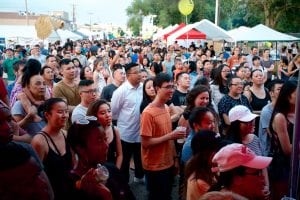
The Asian Economic Development Association’s Little Mekong Night Market in St. Paul. Photo courtesy of Asian Economic Development Association
Helping people build more physical activity into their daily lives can take many forms: increasing access to parks and open spaces, improving bicycle and pedestrian infrastructure, and expanding the use of public transit instead of the single-occupancy vehicle. These solutions have led to the collaboration of public health and urban planning professionals, environmental organizations, and community development practitioners to advocate for transit-oriented development.
On the nutritional side of the equation, one prominent environmental strategy embraced by the public health community in the past decade has been to improve access to healthy food–for example, by attempting to increase the density of full-service grocery stores in USDA-defined “food deserts.” Some places have seen notable results. For example, healthy-food finance initiatives pioneered in Pennsylvania by The Food Trust and The Reinvestment Fund helped grocery stores and smaller fresh-food retailers get started in underserved communities. The initiatives resulted in 88 new or expanded food retail businesses in the region, which generated 5,023 jobs and 1.7 million square feet of new retail space.
Studies of these programs yielded evidence that food retail has a significant economic multiplier effect in those communities. An independent evaluation of the California FreshWorks Fund (CFWF) examined the economic multiplier effect, among other economic and social benefits. They found that three of the CFWF-financed stores in San Diego and Los Angeles County paid over $8 million in employee wages to their low- to moderate-income workers on an annual basis. Through the construction and rehabilitation of these three stores as well as their ongoing operations, the stores have generated over $42 million of economic impact in their respective communities and are expected to generate an additional $33 million annually in these low-income neighborhoods.
Based on this research and a coordinated advocacy campaign, the Healthy Food Financing Initiative (HFFI) was established as a $125 million line item within the Agriculture Act of 2014–known more popularly as the Farm Bill. Since 2011, the U.S. Department of Health and Human Services and the Department of Treasury’s CDFI Fund have distributed more than $197 million through HFFI, leveraging more than $1 billion in additional investments for food projects in 35 states.
Despite the potential of expanded food retail, evidence that the presence of food retailers changes nutritional behaviors–and thus the prevalence of diet-related disease–remains contested. In addition, grocery stores on their own rarely produce the type of broader neighborhood revitalization necessary for equitable economic development.
However, a comprehensive approach can go far beyond grocery stores, blending enterprise development (particularly in low-income communities of color), cultural expression, creative placemaking, and health promotion. By blending these disciplines, practitioners can lead neighborhood-scale food-oriented development with solid results for equity and health.
Beyond Retail
We define food-oriented development as neighborhood- or district-scale development that is centered on food and generates a host of benefits for low-income communities, including:
- Equitable economic development for low-income residents and regional producers
- Genuine expression of the unique cultures found within a given neighborhood or city
- An explicit health-promotion lens
- The creation of a sense of place where arts and culture are embedded in community development
This neighborhood-scale focus is different from the many important regional food systems efforts underway in the United States, which usually cover geographies in several counties and sometimes cross state lines. It’s entirely possible to build a robust regional food system that benefits local producers and serves boutique retailers and high-end restaurants while completely bypassing residents of low-income neighborhoods. Ideally, efforts to build out regional food systems can complement and support neighborhood-scale food-oriented development by providing a robust and diverse supply of locally produced foods (among other benefits), while community development practitioners who use food as a platform for neighborhood revitalization can be sure that low-income residents play a strong role in determining how such development ultimately benefits the community.
Neighborhood-scale, food-oriented development takes several forms. In some cities with declining populations, large tracts of vacant land are being converted to agriculture production; for example, Detroit is now home to more than 1,400 small-scale farms and gardens producing more than 350,000 pounds of fresh produce within its limits. In other cases, development is anchored by a food hub, which enables smaller-scale producers and processors to aggregate their products for institutional purchasers, share facilities that would be unaffordable on their own, and develop commercial networks that can lead to longer-term business sustainability.
The rise of food hubs is one important dynamic in the improved viability of small- to mid-sized food producers. Other relevant trends include the increased priority on local sourcing by institutional purchasers like hospitals and school systems, the sharp rise in the number of farmers’ markets and community-supported agriculture operations, and the increased purchasing power of low-income residents through programs like Food Insecurity Nutrition Incentives.
Two Case Studies
The Hacienda Community Development Corporation in Portland, Oregon, worked with the City of Portland to take an abandoned used car lot located on city-owned land in the Lents neighborhood of Southeast Portland and transform it into the Portland Mercado, the city’s first Latino public market. The Portland Mercado reflects many of the low-income neighborhood’s cultures.
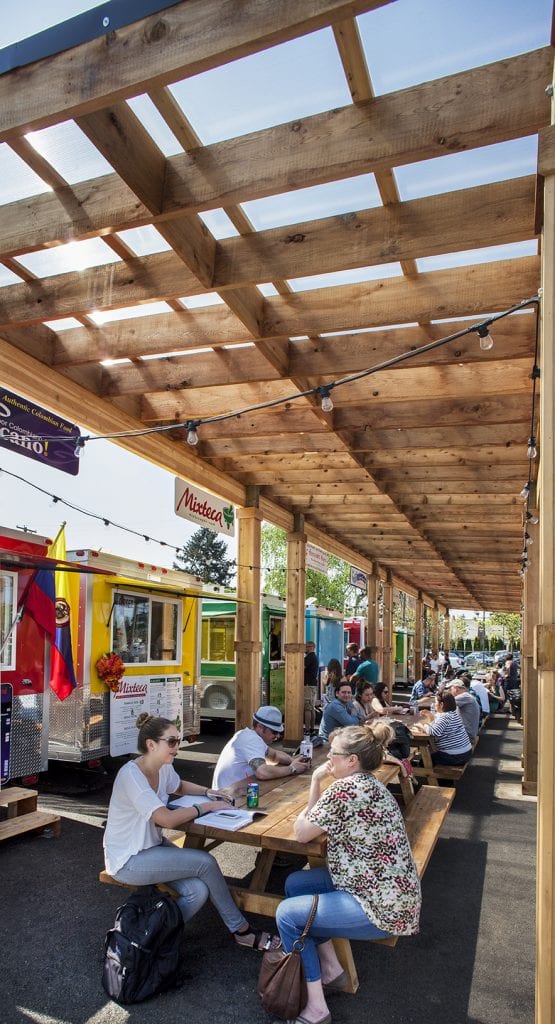
The seating area at the Portland Mercado. The market was created by the Hacienda Community Development Corporation, which worked with the City of Portland to take an abandoned used car lot and turn it into this public market.
Photo courtesy of the Hacienda Community Development Corporation
By the end of its first year of operation, the Portland Mercado had created 114 jobs, supported 19 businesses run by entrepreneurs who hail from more than 20 countries, and generated $2.5 million in gross sales.
Hacienda provides entrepreneurs with business development assistance as well as shared production facilities on-site. The market is also a vibrant cultural space that supports musicians and other performers who represent the area’s Latino, Native American, and other communities. For instance, 43 artists were engaged by the Portland Mercado in its first full year of operation.
The Asian Economic Development Association (AEDA) in St. Paul, Minnesota, is taking a different approach to food-oriented development. Rather than focusing on the renovation of one building, AEDA and its partners are fostering food enterprises throughout the Frogtown and Rondo neighborhoods. Frogtown-Rondo is home to more than 22,000 residents and a diverse range of communities, including but not limited to Hmong, Cambodians, Vietnamese, African Americans, and Latinos. AEDA celebrates this rich tapestry through events such as its Little Mekong Night Market, which this year drew 25,000 people.
After a deep, 18-month community engagement process, in June 2017 AEDA and its partners were ready to launch the “Art of Food in Frogtown-Rondo” initiative. A new community food center, adjacent to Frogtown Farm (a 5.5-acre certified organic demonstration farm), will be the hub of a network of vibrant gardens, restaurants, food-based businesses, art spaces, and pop-up events. The center will be equipped with a commercial and teaching kitchen, community gathering space, art gallery and retail space, greenhouse, classrooms, and cold storage.
Food halls that are mainly occupied by high-end vendors and celebrity chefs might emphasize regionally sourced ingredients and a diverse range of cuisines, but tend to cater to higher-income residents and tourists.
AEDA and Art of Food partners will also offer educational workshops and business development services to Frogtown-Rondo food growers and entrepreneurs. Local artists and community organizers are expected to use creative placemaking strategies to “activate” the future site of the center and link activities and resources at Frogtown Farm with other key sites in Frogtown and Rondo: food businesses along University Avenue, community gardens and home gardeners, neighborhood associations, festival gatherings, churches, and more.
All of this work is being done within a context of neighborhood concerns about maintaining affordability and neighborhood character. Like many cities, St. Paul is experiencing development pressure due to population growth. This growth was accelerated after the completion of the Green Line light rail line in 2015. AEDA and its partners hope that this food-oriented development strategy enables residents to ensure that development builds wealth for existing residents, preserves local culture, and shapes the narrative of Frogtown-Rondo. AEDA and others believe that if residents control how development occurs (including how culture manifests in the built environment and events) they have a better chance of remaining intact as a community than if external market-rate developers determine how it occurs.
Lessons Learned
AEDA and its partners in St. Paul are one of 26 partnerships that received planning grants through an initiative that The Kresge Foundation launched in 2016 called “Fresh, Local and Equitable: Food as a Platform for Creative Neighborhood Revitalization.” (I am deputy director of the foundation’s health program.) FreshLo was co-created by Kresge’s arts and culture and health teams, and invited neighborhood-scale proposals for food-oriented development that met four core criteria:
- Health—Improving access to healthy food
Creative Placemaking—Embedding arts, culture, and community-engaged design in comprehensive development - Economic Development—Creating economic opportunities for low-income residents and businesses
- Equity—Ensuring that low-income residents and communities of color determine the type, scale, and pace of development in their neighborhoods
When Kresge launched a request for proposals for FreshLo, we felt that we were perhaps pushing the boundaries of community development, and did not know how many compelling proposals we would receive. The response upended our expectations: we received 528 proposals, shattering the record for any funding opportunity that The Kresge Foundation had offered in its 93-year history. This response demonstrated that food-oriented development is a much more robust field of practice than previously acknowledged, despite the relatively scant literature that has been published on the topic.
The 26 FreshLo partnerships represent an incredibly diverse range of communities engaged, geographies covered, and approaches to equitable development taken. From the creation of a Creole Food, Arts, and Culture District in the McComb-Veazey neighborhood of Lafayette, Louisiana, to the renewal of a historic open-air market in East Harlem, New York, we have been amazed by the innovation represented in this cohort of grantees. We hope that other community development practitioners find value in the models they are implementing, and we look forward to sharing their stories in the future.
FOD vs. TOD
While it shares similar goals, food-oriented development differs from transit-oriented development in significant ways:
- Scale: Transit-oriented development can manifest at a neighborhood scale but must be integrated into a regional transit system, and so this form of development can be capital intensive (witness the recently approved $2 billion bond issue to expand Atlanta’s transit system). In contrast, food-oriented development can be implemented at many scales and in some cases does not require permanent infrastructure. Thus, food-oriented development offers more accessible development opportunities.
- Financing: We do not finance regional food systems in the same way we finance regional transit systems. Transit-oriented development can be financed through long-established and robust vehicles, typically a mix of local bonding authority and federal transportation grants. Financing food-oriented development has been more challenging, requiring a patchwork of philanthropic grants, New Markets Tax Credits, HFFI grants, subordinated debt, and senior debt. Piecing together food-oriented development financing—like other forms of community development—can require substantial, sustained effort.
- Responsiveness: Major transit infrastructure projects often take years to plan and develop. Despite the best efforts of transit authorities to invite residents to participate in design charrettes, the sheer scale and disruptiveness of infrastructure construction can feel like something done to a community rather than by a community. Further, neighborhoods can change rapidly from the time a project is announced to the time it is complete— often the mere promise of new transit drives up property values and housing costs. Food-oriented development offers opportunities to make small bets on emerging models (e.g., through “pop-up” food enterprises) that can be rapidly iterated in response to community priorities.
- Economic Impact: Experience suggests that the economic multiplier effect of transit-oriented development likely exceeds that of food-oriented development. For instance, the development of the new Q Line in Detroit has already spurred $7 billion in economic activity from a $1 billion public-private investment. Further, jobs in the construction trade are more likely to yield pathways to middle-class wages and benefits than jobs in the food industry. While food-oriented development does offer opportunities for enterprise development, and thus ownership, most jobs in the food industry are still relatively low wage.
- Equity: Low-income communities typically exert little influence over multi-billion infrastructure projects. Our nation’s history is replete with stories of how transportation infrastructure has destroyed the social and economic fabric of communities of color–either by design or by an inability to foresee unintended consequences. Food-oriented development offers opportunities for low-income residents and communities of color to shape their own development priorities.
Potential, Limitations, and Pitfalls
Our experience and observation has demonstrated the potential of food-oriented development to advance community-driven development in ways that celebrate local cultures, improve social cohesion, create a strong sense of place in low-income neighborhoods, enhance access to healthy food, and support entrepreneurship. However, there are some pitfalls to consider.
Like other forms of community development, food-oriented development is not appropriate in areas where residents do not embrace the approach, or the potential to achieve intended outcomes isn’t viable.
The second pitfall relates to the misapplication of food-oriented development to characterize market-rate development that does not expand opportunities for low-income residents, or offer any genuine chance to influence the scope, scale, or intended outcomes of development. Food halls that are mainly occupied by high-end vendors and celebrity chefs might emphasize regionally sourced ingredients and a diverse range of cuisines, but tend to cater to higher-income residents and tourists, and normally aren’t sited in or managed by low-income communities (e.g., the Ferry Building Marketplace in San Francisco or Chelsea Market in New York). Many developers are beginning to realize the financial benefit to co-locating food amenities within residential or commercial developments (i.e., by being able to charge a premium for leases). While co-location with food businesses is becoming more common in market-rate urban development, it should not be confused with the resident-driven development approach described here.
Despite these limitations, food-oriented development is a more widely embraced practice than is currently acknowledged, and holds tremendous promise for creating positive health, economic, cultural, and equity outcomes.

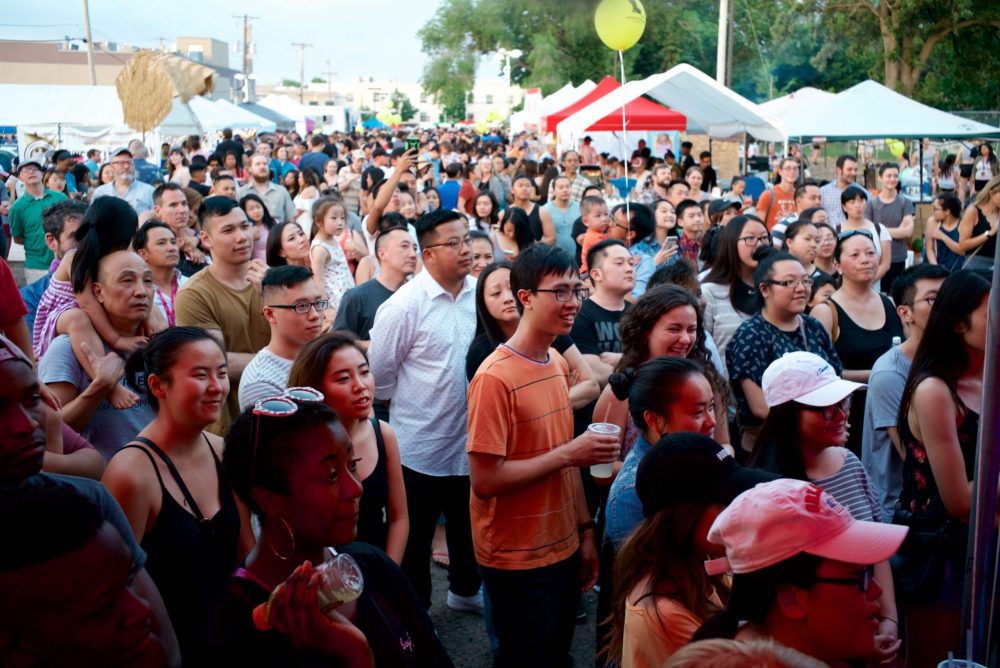

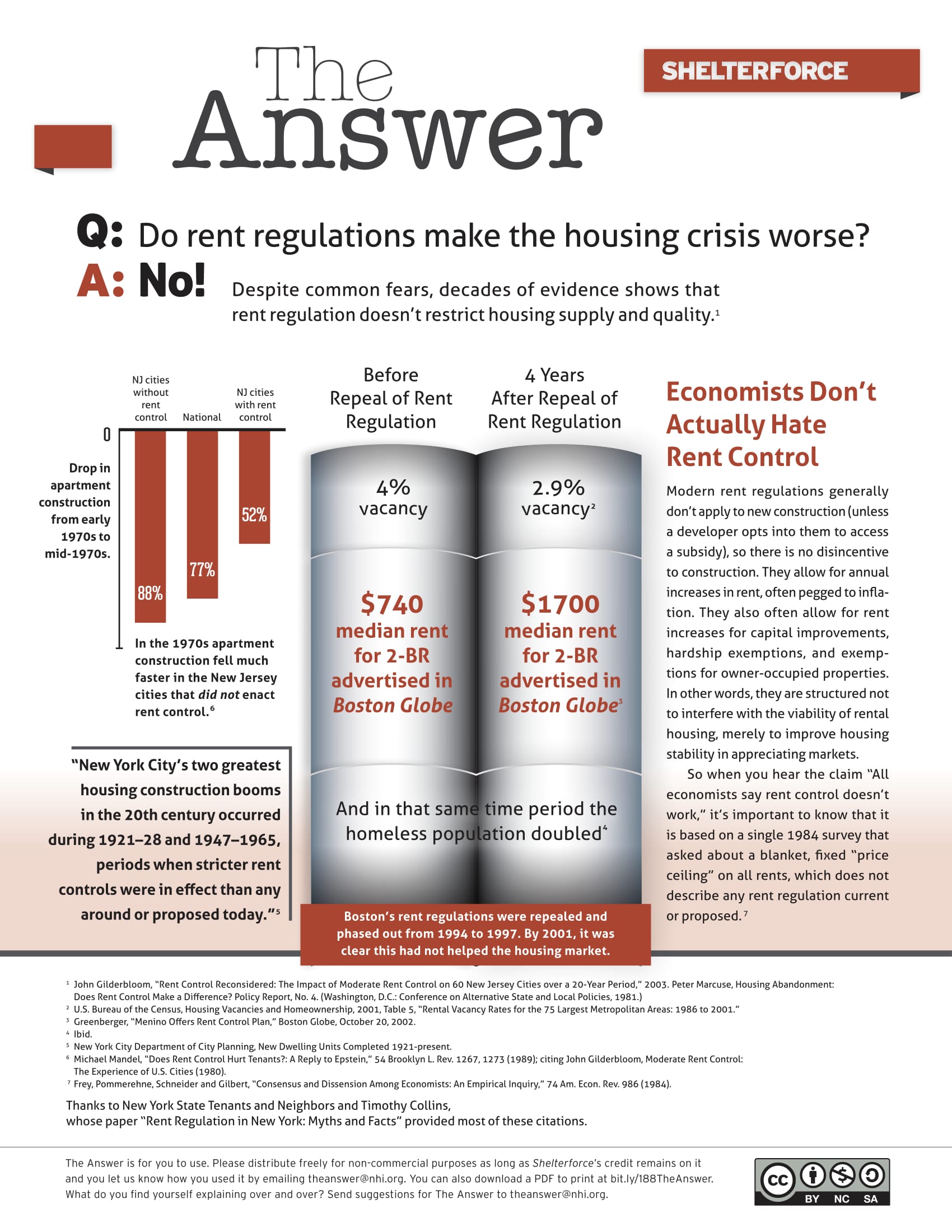
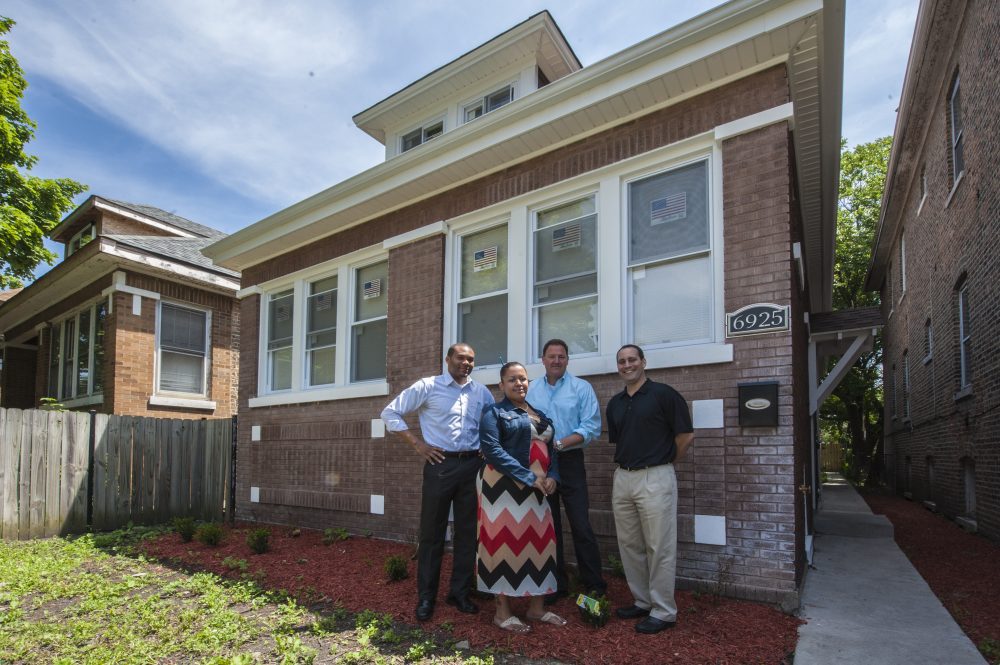
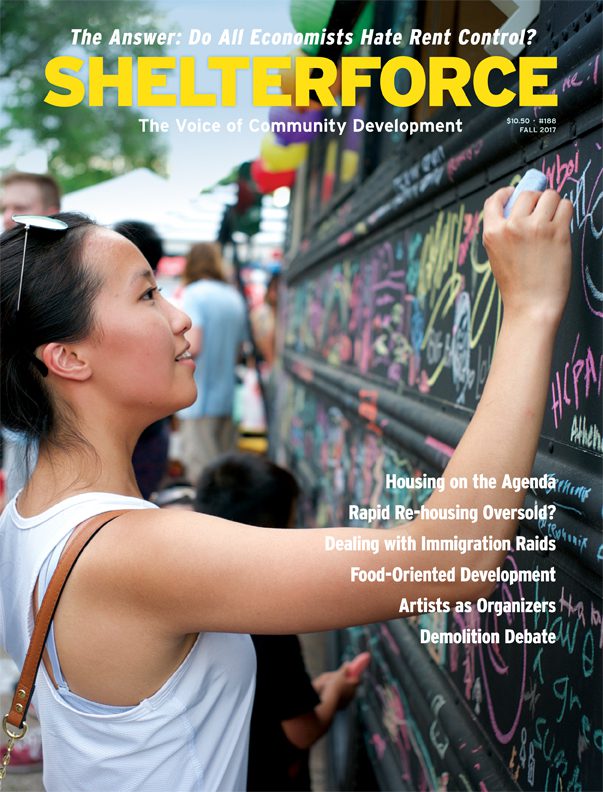
Great piece! Our food business incubator and food manufacturing social enterprise operation here in Boston (CommonWealth Kitchen) was the anchor economic development project for a HUD CHOICE Neighborhoods grant. Our facility, which is located in one of the lowest-income census tracts in Boston, provides space to 50+ food companies, over 75% owned by women and/or people of color, employing over 140 in the busy summer season. We also operated a unique urban food manufacturing social enterprise, providing small-batch processing to local farms, retailers, wholesalers an anchor institutions.
Today, our $2m operation is nearly 50% funded from operations with the balance coming from grants. It’s a model with enormous, broad impact and interesting opportunities for replication. http://www.commonwealthkitchen.org